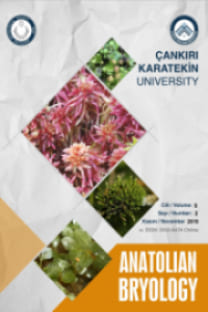Syntrichia ruralis ve Syntrichia montana (Pottiaceae) Taksonlarının Glutatyon
Bu çalışmada, Pottiaceae familyasının, Syntrichia cinsine ait Syntrichia ruralis (Hedw.) F. Weber & D. Mohr. ve Syntrichia montana Nees. taksonlarının indirgenmiş glutatyon (GSH) ve yükseltgenmiş glutatyon (GSSG) miktarları, Yüksek Performanslı Sıvı Kromatografisi (HPLC) ile belirlenmiştir. Syntrichia ruralis ve Syntrichia montana taksonlarının GSH, GSSG miktarlarının sırası ile 81.90 ± 5.68 mg/g, 25.28 ± 2.28 mg/g ile 13.04 ± 1.74 mg/g, 5.68 ± 1.02 mg/g olduğu tespit edilmiştir. Bu miktarlar; Syntrichia ruralis taksonun içerdiği Glutatyon (GSH, GSSG) miktarlarının, Syntrichia montana taksonundan fazla olduğu ve her iki yapraklı karayosunu taksonunda Glutatyon açısından iyi bir kaynak olduğunu göstermiştir. Bu özelliklerinden dolayı bu yapraklı karayosunlarının antioksidan özellikte bitkiler oldukları görülmektedir.
Comparing of Glutathione Ingredients of Syntrichia ruralis and Syntrichia montana (Pottiaceae) Taxa
In this study, Reduced Glutathione (GSH) and Oxidized Glutathione (GSSG) levels of Syntrichia ruralis (Hedw.) F. Weber & D. Mohr. and Syntrichia montana Nees. taxa belongs to Syntrichia type of Pottiaceae family have determined with High-performance Liquid Chromatography (HPLC). It has determined that GSH level is 81.90 ± 5.68 mg/g, 25.28 ± 2.28 mg/g and GSSG level is 13.04 ± 1.74 mg/g, 5.68 ± 1.02 mg/g of Syntrichia ruralis and Syntrichia montana taxa. These amounts have shown that Glutathione (GSH, GSSG) level included in Syntrichia ruralis taxon is more than Syntrichia montana taxon and both of bryophytes-leaved taxa are a good source with regard to Glutathione. It has seen that these bryophytes -leaved are antioxidant featured plants.
Keywords:
Syntrichia ruralis, Syntrichia montana Bryophyte, Glutathione, HPLC,
___
- Abay G. Kamer D. 2010. Biyoçeşitliliğimizin az bilinen bileşenleri ‘Bryofitler’. III. Ulusal Karadeniz Ormancılık Kongresi. 3, 1115-1125.
- Akkuş İ. 1995. Serbest Oksijen Radikalleri ve Fizyopatolojik Etkileri. Mimoza Basım Yayın ve Dağıtım. Konya.
- Arrick B. Nathan C. 1984. Glutathione metabolism as determinant of the therapeutic efficacy: A review. Cancer Res. 33, 4224-32.
- Basile A. Giardano S. Lopez-Sa’ez J.A. Cobianchini C.R. 1999. Antibacterial activity of pure flavonoids isolated from mosses. Phytochemistry. 52, 1479-1482.
- Dawes P. Dawes E. 2000. SGE Chromatography Products Catalog. Sayfa 182.
- Deneke S.M. Fanburg B.L. 1989. Regulation of cellular glutathione. Am J Physiol. 257, L163-L173.
- Elibol B. 2010. Bazı Akrokarpik Karayosunlarının Antifungal ve Antibakteriyel Etkilerinin Belirlenmesi. Ömer Halisdemir Üniversitesi Fen Bilimleri Enstitüsü. Niğde.
- Esterbauer H. Gebicki J. Puhl H. Jgens G. 1992. The role of lipid peroxidation and antioxidants in oxidative modification of LDL. Free Radic Biol Med. 13, 341- 90.
- Glime J.M. Saxena D.K. 1990. Uses of Bryophytes. Today and Tomorrow Printers and Publishers. New Delhi.
- Jimenez A. Hernandez J.A. Pastori G. del Rio L.A. Sevilla F. 1998. Role of the ascorbate-glutathione cycle of mitochondria and peroxisomes in the senescence of pea leaves. Plant Physiol. 118, 1327-35.
- Kidd P.M. 1997. Glutathione: systemic protectant against oxidative and free radical damage. Alternative Medicine Reviews. 2, 155-176.
- Meister A. 1983. Selective modification of glutathione metabolism. Science. 220, 472- 477.
- Meister A. Anderson M.E. 1983. Glutathione. Ann Rev Biochem. 52, 711-760.
- Nelson D.L. Cox M.M. 2000. Lehningers Principles of Biochemistry (3rd ed). Worth Publishers, New York.
- Onat T. Emerk K. Sözmen E.Y. 2002. İnsan Biyokimyası. Yaşlanma Biyokimyası. Sözmen E.Y. Editor(s). Palme Yayıncılık. Ankara. pp. 665-674.
- Öcalan N. 2012. Karayosunlarının Antimikrobiyal Aktivitesi. Erciyes Üniversitesi Eczacılık Fakültesi. Kayseri.
- Öztürk M. Özçelik H. 1991. Doğu Anadolu’nun Faydalı Bitkileri. Siirt İlim Vakfı Yay. Ankara.
- Rausch T. Wachter A. 2005. Sulfur metabolism: A versatile platform for launching defence operations. Trends Plant Sci. 10, 503-509.
- Shibata H. Sasaki N. Hondjoh T. ve ark. 2003. Feline leptin: immunogenic and biological activities of the recombinant protein and its measurement by ELISA. J Vet Med Sci. 65, 1207-1211.
- Uyar G. Hacıoğlu Doğru N. Ören M. Çavuş A. 2016. Determining Antibacterial Activity of Some Mosses (Cinclidotus riparius (Host ex Brid.) Arn., Calliergonella cuspidata (Hedw.) Loeske, Thamnobryum alopecurum (Hedw.) Gangulee, Leucobryum juniperoideum (Brid.) Müll. Hal., Cirriphyllum crassinervium (Taylor) Loeske & M.Fleisch.). Anatolian Bryology. 2:1-2, 1-8.
- Yücel E. Tunay M. 2002. Nazilli (Aydın) ve yöresinde gıda olarak kullanılan yabancı otlar. Türkiye Herboloji Dergisi. 5:2, 10-17.
- Yücel E. Tapırdamaz A. Şengün İ.Y. Yılmaz G. Ak A. 2011. Kisecik Kasabası (Karaman) ve çevresinde bulunan bazı yabani bitkilerin kullanım biçimleri ve besin öğesi içeriklerinin belirlenmesi. Biological Diversity and Conservation. 4:3, 71-82.
- ISSN: 2149-5920
- Yayın Aralığı: Yılda 2 Sayı
- Başlangıç: 2015
- Yayıncı: Çankırı Karatekin Üniversitesi
Sayıdaki Diğer Makaleler
Karadeniz Teknik Üniversitesi Kanuni Kampüsü Briyofit Florası
Hüseyin ERATA, Öznur ÖZEN, Nevzat BATAN, Turan ÖZDEMİR
Pterigynandrum filiforme Hedw. Türünün Antimikrobiyal Aktivitesinin Belirlenmesi
Ali YETGİN, Merve ŞENTURAN, Atakan BENEK, Ebru EFE, Kerem CANLI
Uşak İli Ciğerotları Florasına Katkılar
Muhammet Şamil YAĞLIOĞLU, Gökhan ABAY, İbrahim DEMİRTAŞ, Ayşe ŞAHİN YAĞLIOĞLU
Giresun ili Briyofit Kontrol Listesi, Kuzeydoğu Türkiye
Syntrichia ruralis ve Syntrichia montana (Pottiaceae) Taksonlarının Glutatyon
